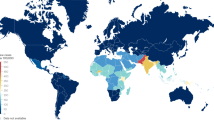Abstract
Objective
To study the epidemiological pattern, clinical picture, the recent trends of multidrug-resistant typhoid fever (MDRTF), and therapeutic response of ofloxacin and ceftriaxone in MDRTF.
Methods
The present prospective randomized controlled parallel study was conducted on 93 blood culture-proven Salmonella typhi children. All MDRTF cases were randomized to treatment with ofloxacin or ceftriaxone.
Results
Of 93 children, 62(66.6%) were MDRTF. 24 cases were below 5 years, 26 between 5–10 years and 12 were above 10 years. Male to female ratio was 1.85: 1. Majority of cases came from lower middle socio-economic classes with poor personal hygiene. Fever was the main presenting symptom. Hepatomegaly and splenomegaly was present in 88% and 46% cases respectively. 19(30.6%) cases developed complications. Mean defervescence time with ceftriaxone and ofloxacin was 4.258 and 4.968 days respectively.
Conclusion
MDRTF is still emerging as serious public and therapeutic challenge. Ceftriaxone is well-tolerated and effective drug but expensive whereas ofloxacin is safe, cost-effective and therapeutic alternative in treatment of MDRTF in children with comparable efficacy to ceftriaxone.
Similar content being viewed by others
References
Wasfy MO, Oyofo BA, David JC et al. Isolations and antibiotic susceptibility of Salmonella, Shigella, and Campylobacter from acute enteric infections in Egypt. J Health Popul Nutr 2000; 18: 33–38.
Ivanoff B, Levine MM, Lambert PH. Vaccination against typhoid fever: present status. Bull World Health Organ 1994; 72: 957–971.
Agarwal K S, Singh S K, Kumar N et al. A study of current trends in enteric fever. J Commun Dis 1998; 30(3): 171–174.
Sood S, Kapil A, Das B, Jain Y, Kabra SK. Re-emergence of chloramphenicol-sensitive Salmonella typhi. Lancet 1999; 353: 1241–1242.
Sinha A, Sazawal S, Kumar R et al. Typhoid fever in children aged less than 5 years. Lancet 1999; 354: 734–737.
Kabra S K, Kabra M, Talati A, Soni N, Patel S, Modi R R. Multidrug-resistant typhoid fever. Trop Doct 2000; 30: 195–197.
Wongsawat J, Pancharoen C, Thisyakorn U. Typhoid fever in children: Experience in King Chulalongkorn Memorial Hospital. J Med Assoc Thai 2002; 85: 1247–1250.
Bhutta ZA, Naqvi SH, Razzaq ZA et al. Mutidrug-resistant typhoid in children: Presentation and Clinical features. Rev Infect Dis 1991; 13: 832–836.
Rasaily R, Dutta P, Saha MR, Mitra U et al. Multidrug-resistant typhoid fever in hospitalized children: clinical, bacteriological and epidemiological profiles. Eur J Epidemiol 1994; 10: 41–46.
Koul P B, Murali M V, Sharma P P, Ghai O P, et al. Multidrug-resistant Salmonella typhi infection: clinical profile and therapy. Indian Pediatr 1991; 28: 352–356.
Garg K, Mangal N, Mathur HC. Clinical profile of multidrug-resistant typhoid fever in Jaipur city. Indian Pediatr 1994; 31: 191–193.
Chandra R, Srinivasan S, Nalini P, Rao RS. Multidrug-resistant enteric fever. J Trop Med Hyg 1992; 95: 284–287.
Johnson AOK, Aderele WI. Enteric fever in childhood. J Trop Med Hyg 1981; 84: 29–35.
Vallenas C, Hernandez H, Kay B et al. Efficacy of bone marrow, blood, stool and duodenal contents culture for bacteriologic confirmation of typhoid fever in children. Pediatr Infect Dis 1985; 4: 496–498.
Osler W. Hepatic complication of typhoid fever. Johns Hopkins Hosp Rep 1899; 8: 373–387.
Ramchandaran S, Godfrey JJ, Perera MVF. Typhoid hepatitis. J Am Med Assoc 1974; 230: 236–240.
Biswal N, Mathai B, Bhatia B D, Srinivasan S et al. Enteric fever: A changing perspective. Indian Pediatr 1994; 31: 813–819.
Burnett J W. Uncommon bacterial infections of skin. Arch Dermat 1962; 86: 597–607.
Smith MD, Duong NM, Hoa NT et al. Comparison of ofloxacin and ceftriaxone for short-course treatment of enteric fever. Antimicrob Agents Chemother 1994; 38: 1716–1720.
Asperilla MO, Smego RAJr, Scott LK. Quinolone antibiotics in the treatment of Salmonella infections. Rev Infec Dis 1990; 12: 873–879.
Ramsey BW. Management of pulmonary disease in patients with cystic fibrosis. N Eng J Med 1996; 335: 179–188.
Author information
Authors and Affiliations
Corresponding author
Rights and permissions
About this article
Cite this article
Kumar, R., Gupta, N. & Shalini Multidrug — resistant typhoid fever. Indian J Pediatr 74, 39–42 (2007). https://doi.org/10.1007/s12098-007-0024-z
Published:
Issue Date:
DOI: https://doi.org/10.1007/s12098-007-0024-z




